Summer Exercise For Dogs
Summer is in the air; the days are getting longer and warmer, which is ideal weather for spending more time outdoors with our dogs. As we transition away from short days and cool weather, we must be mindful of how, when and where we exercise our dogs. Read more about exercising your dog in the summer:
Fun Ways to Exercise in Summer
Going out and spending time actively with our dogs is a favourite pastime of many, especially during the warmer months. Often the number of activities dogs are asked to do during the winter months is reduced, so before going out and engaging in those summer activities, you love to do, such as; swimming, playing fetch, catching a frisbee, playing ball in the shallows of the lake or on the beach, or simply jogging in the park – think about how fit your dog is, and, how tolerant to the heat are they?
Some activities are more physically challenging for the dog, so before setting out, consider if your dog has the strength, endurance, flexibility, balance, and coordination to perform the exercises safely. Keeping our dogs fit and healthy helps reduce the risk of injury; however, if their fitness has dwindled over the winter months, we need to increase the exercise gradually and incorporate all the key components of fitness into their routine.
Furthermore, as the days get longer and warmer, we need to monitor our dog’s response to exercising in the heat. Each dog will respond differently to exercising in the warmer weather, with coat, breed, size, weight, and fitness all playing a role when devising an exercise plan that is appropriate for your dog.
Let’s explore some great ways to get your dog fit for summer.
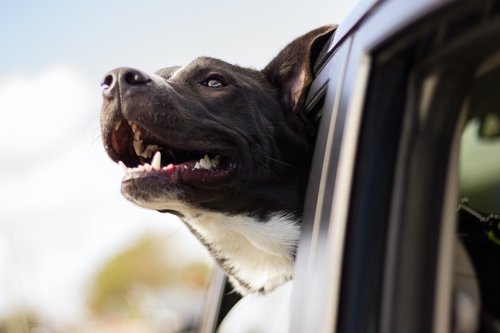
Hiking Through Cool Forests
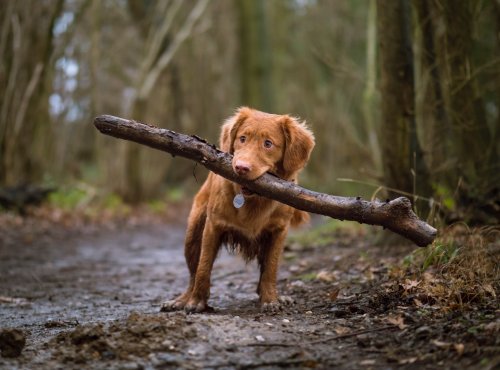
Hiking along forest paths surrounded by the deep shade of tall trees is an excellent idea for spending a day outdoors. It can be a light walk or trail running if you and your dog are in good shape or want a challenging workout. Slower paces allow the dog to sniff and explore the terrain in more detail – which is an incredibly enriching mental activity for them. Faster paces will build their cardiovascular systems. However, this will create excess heat that the dog will need to shed, so try exploring trails with a creek, where your dog can cool down by swimming or splashing around.
Many dogs will find it difficult to resist the urge to occasionally sneak through the bushes and off the beaten path, increasing the chance of encountering wild animals, such as snakes, other dogs, or other hikers. Therefore, you should always keep a watchful eye on your dog when in nature. If you come across a fellow walker with or without a dog, recall your dog and pop them on lead so you can practice polite greetings as you pass.
Swimming at the Beach or Lake
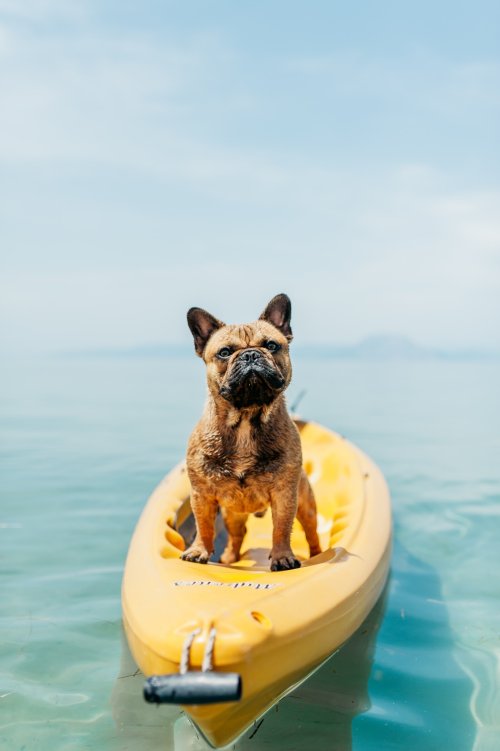
Immersing ourselves in the refreshing sea or lake water during a hot summer day can be very relaxing, quenching our body's desire to cool off. Our dogs are no different, and they love good refreshments, too. Some dogs love to swim, whilst others are happier to paddle at the edge of the water.
Not all dogs enjoy deep waters! If your dog is not a swimmer but still likes to be near the water or go on boat trips with you, be sure to put on a life vest with a strap along the back so that you can remove your dog from the water as quickly as possible if it accidentally falls in or goes too deep. Always start in the shallow water when your dog is first learning to swim; this allows you to jump in to help if the dog gets tired or panics.
Water play is best done earlier in the morning or the late afternoon; this allows the dog to sleep through the hottest part of the day and helps avoid crowds. The UV index is generally at its highest during the middle part of the day, so morning and evening play reduces their risk of sunburn and burns to their paws from the hot ground or sand.
Some dogs are passionate about water games and swimming; if this sounds like your dog – know that hyperarousal can override their sense of self-preservation, so keep an eye on them; watch for signs of fatigue or excessive water intake. After swimming in salt water, dog owners should rinse off their dogs thoroughly as salt may irritate their skin.
Cool water has the added benefit of reducing inflammation; swimming or paddling can be an excellent activity for older dogs with joint inflammation. Swimming can also be a good exercise for fit, healthy dogs. For dogs with muscle strains or soft tissue injuries, swimming may pose a risk of exacerbating the injury. Talk to your veterinarian or rehab professional before swimming if your dog has an injury.
Finally, it is essential to review the label of your flea or tick preventative; many products that are applied to the coat are not waterproof and will wash off in the water. Owners may need to consider alternative means to prevent fleas and ticks; many owners switch to a chew tablet or removable collar during the summer – if you’re unsure what is best for your dog, please consult your veterinarian.
Walks in the Cooler Parts of the Day
Appropriate exercise and regular walks are equally important year-round; however, as the days get warmer, we must avoid exercising in the hottest part of the day. It doesn’t take long for the sun-exposed ground to exceed temperatures that are safe to walk on, with manufactured surfaces such as synthetic turf, concrete, or asphalt often becoming unbearable to walk on.
Dogs use their paws to help regulate their internal temperature; however, when the ground surface temperature exceeds internal body temperature, heat flows into the dog via the paws rather than out – increasing the risk of a heat injury. Localised heat injuries may manifest as blisters or burns on the paws, and internal heat injuries that cause the body to overheat can be life-threatening. For this reason, summer walks should be limited to the time of the day when the temperature is slightly lower, and the air is cooler, i.e. early morning and evening.
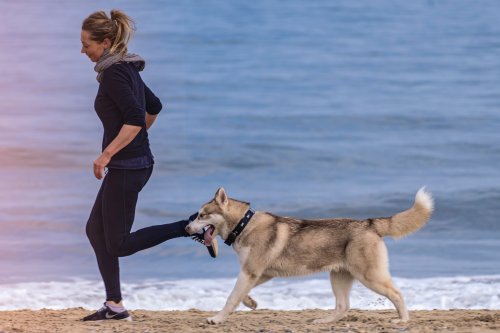
Change the exercises regularly to make them fun for you and your dog. Alternate days of long slow walks and short runs, or if you go swimming one day, you can go hiking the next. Exercising should be fun for both you and your dog, enriching your lives through activities while building fitness.
Indoor Exercises
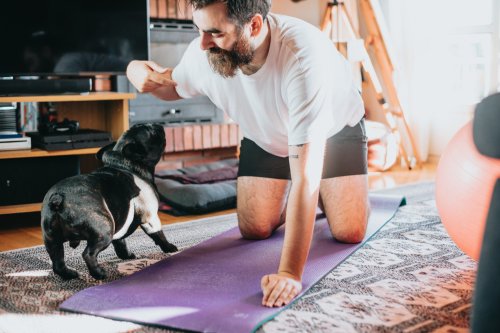
Sometimes it’s just not safe to get out and exercise, but that doesn’t mean your dog needs to miss out. If you’ve got a nice cool room with even a small space, you can still do workouts with your dog. Please contact us; we can create an individualised canine fitness plan to build your dog’s strength, flexibility, and proprioception without leaving home.
Considerations When Exercising Your Dog in Summer
Before the heat hits, and especially if you want to include new exercises and activities in your dog's routine, you should consider how your dog responds to exercising in the summer heat and extreme weather, as excess heat can seriously compromise your dog's health. So, before you begin, consider the following:
1. What is the air temperature and humidity when you plan to go out with your dog? What is the temperature of the ground, and can it cause burns on the dog's feet?
2. What is the current fitness of your dog? Are there any medical conditions (such as arthritis) that could be worsened by heat exposure? If you are not sure, consult your veterinarian about this subject.
3. Do you know how to recognise heat stress in a dog? And if that happens, do you know how to react appropriately in that case? We write more about this topic below.
Before Starting a New Exercise Regime
If you have decided that this summer is the right time to start a new exercise regime and get your dog fit, you should talk to a Certified Professional Canine Fitness Trainer. This way, you will receive expert advice tailored to your dog and its physical condition (especially if it's an older dog, is overweight, or is out of condition). You can learn how to improve your exercise plans and reduce potential risks.
Connecting with a fitness trainer will allow your dog to be expertly guided through regular exercise and teach you, the owner, how to approach your dog's future activities. Canine training classes with a fitness trainer include mastering techniques and behaviour for optimal performance while simultaneously having the least risk of causing injury to dogs. Introducing new exercise regimens is the ideal time to acquire these habits and techniques so that the benefits of exercise are as long-lasting as possible.
In addition to changes in physical activity, it's essential to observe your dog's diet. A dog needs to be healthy to handle increased physical efforts, and a balanced diet plays an important role. This is essential if you expect peak physical performance and health well-being for your pet. For strength and enough energy, look for high-quality foods with natural animal protein. In one of our earlier articles, we wrote about how to read dog food labels, and what chicken meal in dog food is. You can learn more about the nutritional value your pet gets from the food you buy.
In addition to food, water is, of course, indispensable! Fresh, clean water must always be available to the dog - especially during the summer when the body requires more fluid to regulate itself. Ensure there is more than one water source available for your dog at home, and pack a drink for them on any outing; even the excitement from travelling in the car can increase their thirst.
Considering your dog’s water and food intake when engaging in an exercise plan is essential. We also need to consider the impact exercise has on joints and the micronutrients required by the body to keep joints in optimal condition. Adding supplements to your dog's diet is a great way to get the essentials; we recommend that owners supplement their dog's diet with Antinol Rapid. Antinol is made with all-natural ingredients and has been scientifically proven to improve joint health. It’s a natural anti-inflammatory that supports healthy skin and coat, so your dog will not only feel great but also look great. This product can be used proactively to promote wellness which is why we recommend it to most dogs. You can read more about the product here.
Is Your Dog Ready to Start Exercising?

Before you start a new exercise regime or increase your weekend adventure activities, think about your dog and consider – are they physically and emotionally ready.
Just as the consequences for people who don't exercise regularly and then suddenly decide to run 5 miles can be harmful, the same is true for dogs. Exercises should be introduced gradually, with rest days incorporated into their program. Endurance takes time to develop, and their bodies need time to get used to a new, more challenging rhythm.
Overweight or obese dogs are especially susceptible to injury from overexercising. Overexertion may lead to health-threatening situations that can be avoided by consulting with a veterinarian before starting exercise and having a suitable exercise plan tailored to your individual dog's requirements.
Is My Dog Overweight?
It is common in some parts of the world to see dogs that are overweight or obese, so although it may be seen as the norm – it doesn’t mean it’s healthy or best for your dog. So, how can you tell if your dog is overweight?
Firstly, we do the feel test, run your fingers along the side of your dog's body; can you feel your dog's ribs without excess fat covering them? If you cannot feel your dog’s ribs, it’s a sure sign that they carry excess fat.
Next, look at your dog from the side; does their waist tuck up at the abdomen?
Finally, look at your dog from above; do you see their sides tuck in through the abdominal region?
A dog whose ribs are just palpable, whose waist tucks in and up, would have an ideal body condition score. Any excessive pronunciation of any of these would indicate that the dog is underweight, which can also compromise health. Correctly storing your dog’s body condition can be tricky when first learning, so get in contact with us; we can guide you through the process. A better understanding of your dog's condition will lead you, as the handler, to make more informed decisions, promoting your dog's health.
Achieving and maintaining an ideal body condition is a long-term but essential process if your dog suffers from excessive weight or fat. Although recently it has become popular to see overweight pets (especially on social media), being in such a state is not optimal for their health. Like humans, overweight dogs can develop severe conditions such as diabetes, arthritis, and poor joint health. Therefore, achieving a weight reduction goal is essential, but ensure this is done in consultation with experts with gradual, consistent work.
Heat Stress: When Your Dog Has Become Too Hot
During summer activities, it is vital to provide your dog with ways to cool their body. Dogs with more insulation (thick coats or excessive fat) can be more susceptible to heat injuries – especially when the weather is warmer; however, heat injuries can and do still occur in cooler weather. They can cool their body more readily by providing a water source where the dog can lie or splash around. Be mindful of water exposed to significant thermal radiation from the sun, as it will quickly warm up and be less efficient at cooling than shaded water at a lower temperature.
Heat injuries occur when there is too much internal heat, this can be created either by increasing the metabolic rate through exercises or when the ambient temperature is so hot that the dog cannot shed their normal heat. Laying in the sun on a hot day is an easy way to overheat quickly, so even if you’re not exercising, it’s essential to pay attention to the temperature, humidity and about of thermal radiation your dog is exposed to. During heatwaves, you should be especially careful, and if necessary, avoid evening exercises (because the heat can linger for a long time) and limit yourself to short walks only.
Another thing to keep an eye on is your dog's arousal state. Dogs in high arousal may not show signs of fatigue and heat stress very obviously, so the state of arousal of your dog is something to observe during the summer months. React in time, and stop the game before it becomes dangerous. You should always give your dog access to drinking water before and after exercise and keep an eye on them to spot signs of heat distress.
Signs of Heat Distress
According to Small Animal Clinical Nutrition, during exercise in hot weather, the body's heat can exceed the respiratory tract's ability (panting) to cool the body down. Prolonged exposure to such a condition can be hazardous for a dog. Therefore it’s essential to observe your dog during summer activities closely.
Signs of heat distress are as follows: panting heavily and incessantly, salivating excessively, collapse, reg gums, or heavy breathing. If you notice this in your dog, immediately stop the activities and start cooling the dog down.
Actions to Take
If you notice signs of heat distress, take the following steps:
stop exercising
keep your dog out of the sun
offer a small amount of fresh, clean, cool water
invite the dog to cool off in a body of water (if there is one nearby)
call your veterinarian if your dog is unable to cool down
Fatigue in Dogs
Although it is not as dangerous as heat distress, it's equally important to notice the dog's fatigue and, ideally, stop the exercise and physical activity before the dog gets completely tired. How to recognise a fatigued dog? It loses interest in its day-to-day activities and gets up with difficulty and reluctance. It may show movement problems and might be interested in food. Consult a veterinarian if this condition persists, and give your dog enough rest.
Mental health
In addition to your dog's physical health, taking care of its emotional and mental health is essential. Provide your dog with as many fun and stimulating games as possible that will regularly help exercise its cognitive abilities.
But at the same time, observe your dog: does it show disinterest in a specific type of exercise? Try to adapt and find something fun for both of you. Does your pet look stiff and sore? It's time to treat your pup with the luxury of Bowen therapy!
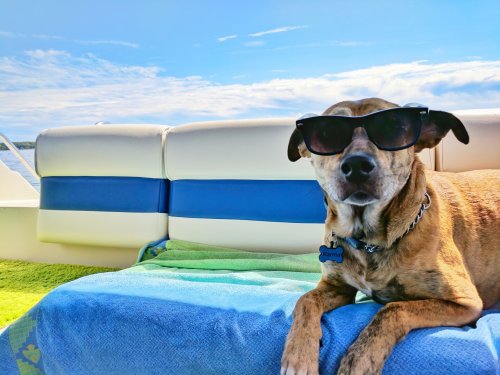


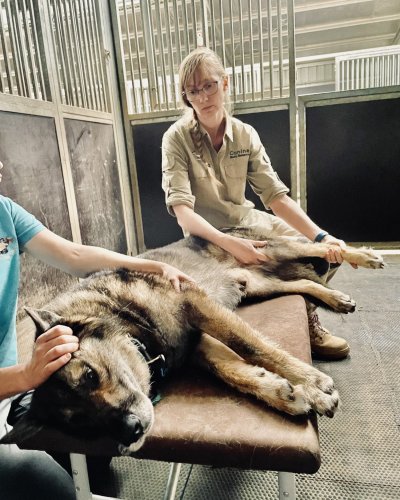


Leave a comment